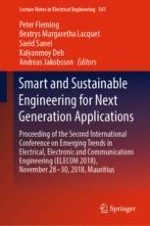2019 | Book
Smart and Sustainable Engineering for Next Generation Applications
Proceeding of the Second International Conference on Emerging Trends in Electrical, Electronic and Communications Engineering (ELECOM 2018), November 28–30, 2018, Mauritius
Editors: Prof. Dr. Peter Fleming, Prof. Dr. Beatrys Margaretha Lacquet, Prof. Dr. Saeid Sanei, Prof. Dr. Kalyanmoy Deb, Andreas Jakobsson
Publisher: Springer International Publishing
Book Series : Lecture Notes in Electrical Engineering
